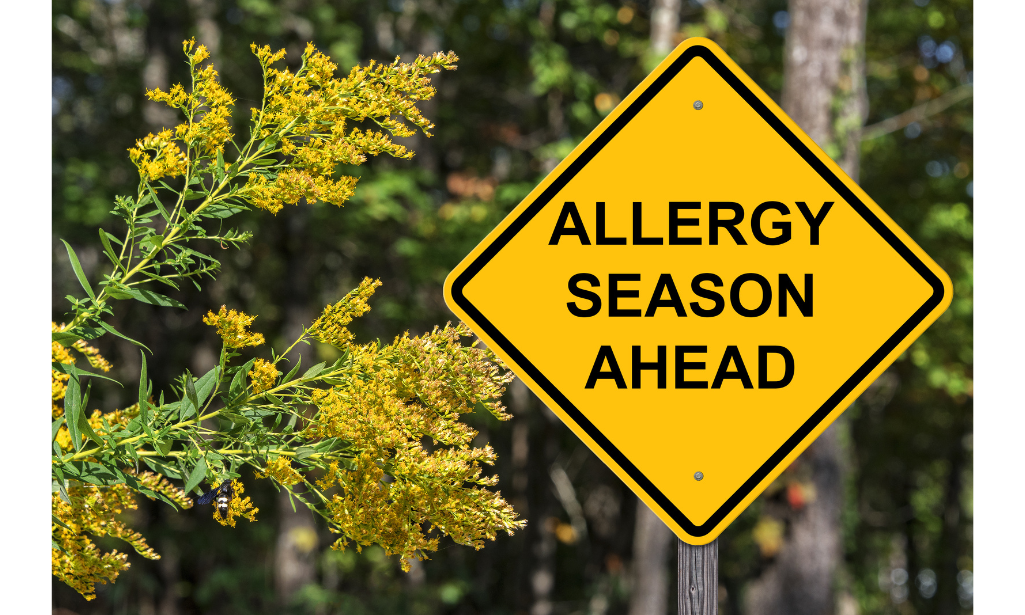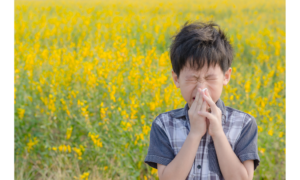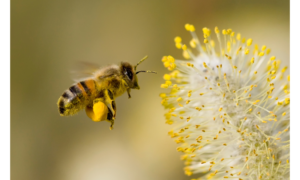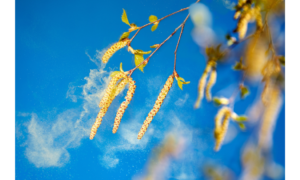Spring is a beautiful time of year…for some people. “Some?”, you’re probably asking yourself. Who doesn’t love the warmer temperatures, the birds chirping, the trees and flowers blossoming and blooming? Well, it’s that last part that quite a few people have a problem with. Not visually, of course. Springtime flowers and trees mean vibrant colors and sweet scents. No, it’s the spring allergies–with the itchy and watery eyes, sneezing, congestion, and other not-so-fun ailments–that dampen the otherwise bright and festive mood of spring for millions of people. In Today’s Lesson, we’re going to discuss what causes spring allergies, and you’ll have a chance to conduct an at-home experiment!
What causes our spring allergies?
The short answer? Bees. Well, not just bees. Lots of other animals too. The longer answer is pollination. So, what is pollination? According to the U.S. Department of Agriculture’s Forest Service (USDA), pollination is the act of transferring pollen grains from the male anther of a flower to the female stigma.
Just like other organisms, plants look to reproduce, and one way they do so is by making seeds. Seeds hold the genetic information necessary to produce a new plant, and flowers are what plants use to make their seeds. But seeds can only be produced when pollen is transferred between flowers of the same species. Which leads to the question…
How does pollen travel from one flower to another?
This is where bees–and wind and other insects and bats and butterflies and water–come into play. These “pollinators” spread the pollen from one flower to another, usually without even knowing it. Pollinators, bees being the most famous, eat or collect the pollen for its nutrients or drink the nectar from the flower when pollen grains attach to the animal’s body. Once a pollinator is done with one flower, it moves to the next one, where the pollen attached to their bodies often falls onto the flower’s stigma, thus pollinating the new flower and allowing it to reproduce.
Basically, these pollinators are carriers of pollen from one source to another. And in the process, the pollen is also landing on outdoor surfaces such as cars and furniture and flying around in the air…and into our noses and mouths.
What makes people allergic to pollen?
The problems for people with pollen allergies begin when the pollen is breathed into the body. From there, the immune system treats the pollen as a dangerous substance trying to harm you (when it really isn’t). This results in the immune system trying to protect you by producing a chemical called histamine to fight the pollen. The histamine is what causes the allergic reaction–and the allergen is the pollen. You know the end results here…all those symptoms that make you want to stay indoors all spring long.
People with pollen allergies generally experience their worst symptoms in the spring, though many suffer with these allergies all year long. And, unfortunately, once you develop a pollen allergy, you’re likely stuck with it for the long term. Medicines and allergy shots can help alleviate the symptoms, but as long as that yellowy powder is floating through the air, you’re going to breathe it in.
Time to pollinate!
The process of pollination is a fascinating one–and it is one that is very difficult to witness with your own eyes. So, with this cool experiment from the Children’s Museum of Indianapolis, you’re going to get an up-close look at how pollination works using…cheese curls!
What You’ll Need
- Paper towels
- Scissors
- A large bowl
- Cheese curls
- Individual piece of candy (like Starburst or a “fun size” candy bar)
Steps
- Cut some flower shapes out of the paper towels. Lay a piece of candy (in its wrapper) in the center of each flower.
- Add a few more wrapped candies to the bottom of the bowl, then fill it the rest of the way with cheese curls. This is your first flower.
- Now dig your hand through the cheese curls (your hands will get messy!) and feel around until you find one of the candies. Grab a piece and pull it out.
- Then, using the same dirty-yellow-cheese-curl-residue hand, pick up a piece of candy from your paper towel flowers.
What happened?
The candy in this experiment was the nectar, which many insects and hummingbirds enjoy eating. The cheese curls themselves served as the flower’s stamen, which is the part that produces pollen. Part of the stamen is usually coated in pollen–so a cheese curl and its powdery cheesy coating are natural substitutes for the stamen. Anyway, when the pollinating insect or bird lands on a flower and drinks nectar and moves about, pollen sticks to them just like the cheese curl powder stuck to your hand.
Then, when you moved your cheese powder-covered hand to the paper towel flower, you transferred it to the paper towel–just like a pollinator transfers pollen that’s stuck to its body to the next flower it lands on. From there, the pollen makes its way down to the pistil, where it combines with the ovule to create a seed.
So, if cheese curl residue was actually pollen and a paper towel flower had actual plant parts, you’d have pollinated it and created a seed–congratulations!
In conclusion…
Pollination is a vital piece of our world–without it, plants and flowers could not reproduce. And we all know how important plants and flowers are to our ecosystem. The unfortunate side effect is the seasonal allergies that so many people experience, especially in the spring. The silver lining is that we can take medications to treat pollen allergies. But without pollination, well, the USDA estimates that pollinators help pollinate approximately 75 percent of the world’s flowering plants. They also pollinate roughly 35 percent of the world’s food crops—including fruits and vegetables. The bottom line is, if pollination didn’t exist, we probably wouldn’t either. That makes our seasonal allergies a little bit easier to tolerate.
We hope you enjoyed Today’s Lesson! Subscribe to our blog for more fun lesson ideas and creative homeschooling tips and tricks!!












